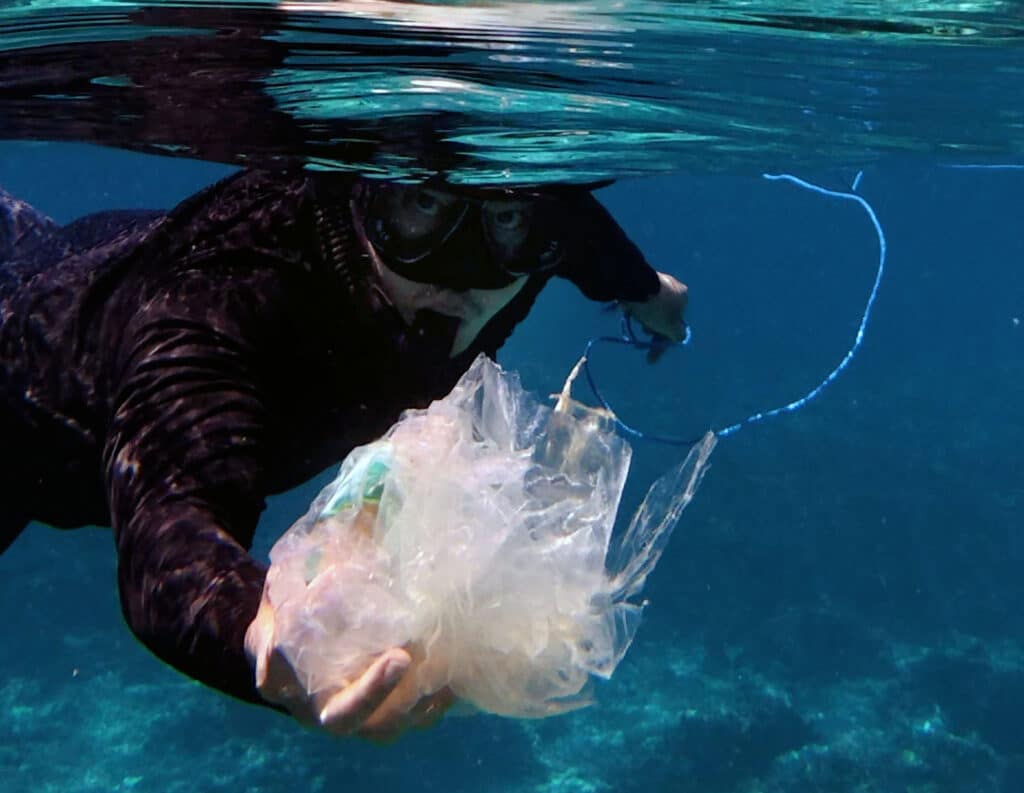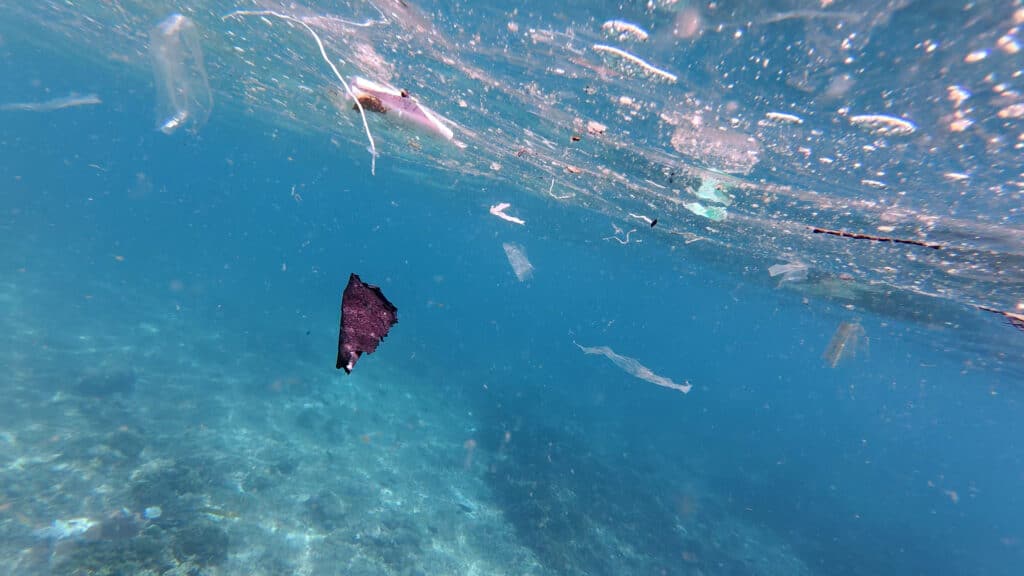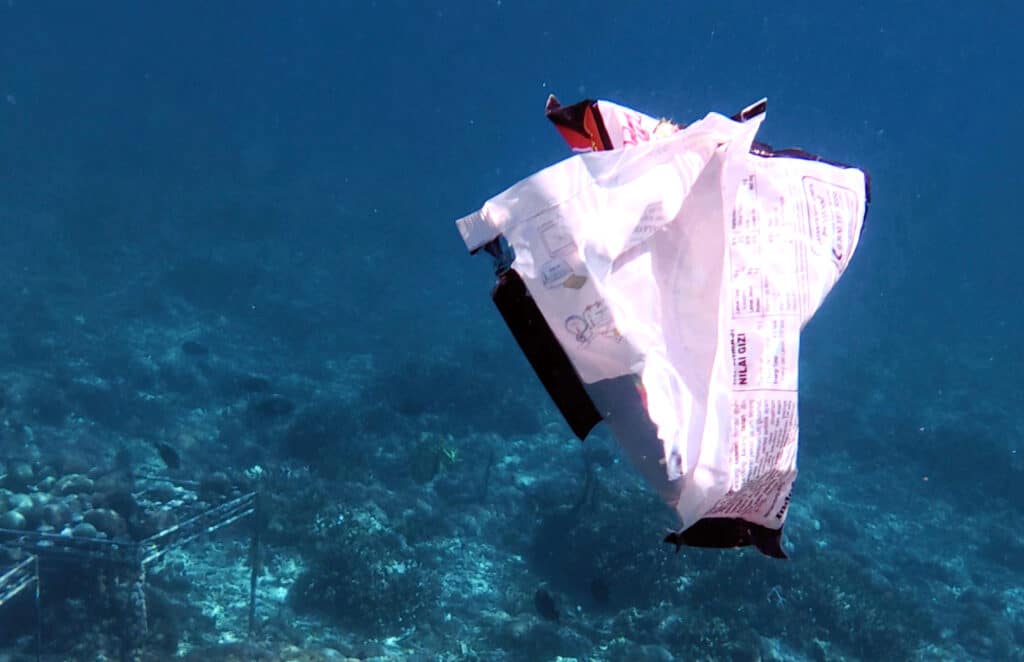The vivid blue waters surrounding Bali, renowned for their vibrant marine life and breathtaking dive sites like Tulamben, Amed, and Nusa Penida, are often depicted as an aquatic paradise. Yet, in our recent dives, we wading through a disheartening scene of plastic debris everywhere. Lately, Bali’s beaches have also made headlines for the tidal waves of never ending plastic marring the beaches. Bali recently escalated its fight in 2025, banning all small plastic bottled drinking water under 1 litre. This cannot come at a better time as we are strangulating the Bali reefs with plastic.

The escalating plastic crisis directly jeopardizes Bali’s core economic driver – tourism – transforming the plastic ban into an urgent economic imperative. The high volume of visitors, attracting nearly 6.5 million tourists annually, inherently leads to increased waste generation, undermining the very beauty that draws them.9
Furthermore, Bali’s plastic pollution problem is significantly exacerbated by transboundary waste flows. A considerable portion of the plastic washing up on Bali’s beaches, particularly during the monsoon season, originates from other Indonesian provinces like East Java and Kalimantan, carried by the “Indonesian Throughflow” current.6 This external contribution means that local bans, while critical for internal control, must be complemented by wider regional waste management improvements and international collaboration.
Staggering Waste Statistics
Bali currently generates an alarming volume of waste, estimated at around 3,436 tonnes daily 9 or 1.2 million tons annually.8 While organic waste dominates, plastic waste is a significant problem, with only about 17% considered recyclable.12 Waste generation increased by 30% from 2000 to 2024, due to lack of awareness, limited infrastructure, and a consumptive lifestyle.19
Bali’s Final Waste Disposal Sites (TPAs), including the crucial Suwung landfill, have reached full capacity, leading to illegal dumping.17 This highlights a critical infrastructure-behavior gap: even with good intentions, the system cannot handle the waste.3 While the ban faces economic concerns, waste processing is expensive ($100/ton), making “waste reduction the cheapest option”.19 The ban is a strategic economic investment to prevent larger future costs from environmental degradation and protect tourism.9
Foundations: The 2018 Single-Use Plastic Ban
The foundational step was Gubernatorial Regulation No. 97 of 2018 (Pergub 97/2018), introduced in December 2018. This landmark initiative aimed to significantly cut marine plastic waste by 70% within a year.13
Pergub 97/2018 specifically targeted plastic bags, Styrofoam, and plastic straws.13 It mandated producers, distributors, and businesses to switch to alternatives, and called upon individuals and communities to cease using disposable plastic.13 Despite protests from business owners, the Supreme Court upheld the regulation, affirming its strong legal position and the urgent need for such “extraordinary policy”.13 However, subsequent environmental audits, like the Sungai Watch 2024 Impact Report, show plastic bags are still among the most frequently found waste items in Bali’s rivers, indicating challenges in enforcement and the need for viable alternatives.15

The Latest Mandate: Circular Letter No. 9 of 2025
On April 2, 2025, Governor I Wayan Koster issued Circular Letter No. 9 of 2025 (CL 9/2025), marking a significant escalation. This aims to address growing concerns over waste accumulation and the critical overcapacity of the island’s Final Waste Disposal Sites (TPAs).9
CL 9/2025 specifically targets the entire value chain of small plastic bottled drinking water. It prohibits the production, distribution, and provision of single-use plastic bottled drinking water in volumes of less than 1 liter, including plastic cups and half-liter containers.9 This comprehensive ban is the first of its kind in Indonesia to specifically address small plastic bottles.9 Environmental audits identified bottled drinks as “top 10 polluting brands in Bali and Banyuwangi rivers,” making this a strategic intervention for immediate reduction of visible pollution.9
However, a critical legal detail is that circular letters are not formally recognized within Indonesia’s hierarchy of binding legal instruments, unlike the 2018 Gubernatorial Regulation.17 This distinction implies that despite strong political will, the legal foundation of CL 9/2025 might be weaker without further legislative backing.
Implementation and Enforcement
The circular memorandum explicitly targets six key sectors for plastic waste reduction: government offices, traditional villages, businesses, hotels and restaurants, educational institutions, marketplaces, and places of worship.15
The “Bali Clean Waste Movement,” launched in March 2025, sets an ambitious target of making the island waste-free by 2027.9 The ban on plastic products under one liter will be fully enforced by January 2026, extending to malls and hotels.7 Notably, 96% of Bali’s 1,500 traditional villages have proactively enacted their own customary regulations with similar plastic restrictions, effective July 2025, showing strong grassroots commitment.7
Violations may result in administrative sanctions like public disclosure, administrative reviews, and potential revocation of business licenses. Traditional villages failing to comply risk losing financial support. Conversely, supporters will receive incentives, fostering a balanced approach.9 A cornerstone is waste segregation at the source across public institutions, businesses, schools, markets, and religious sites.9
Bali’s strategy uniquely combines formal provincial mandates with traditional customary laws, potentially enhancing compliance and local ownership.9 Governor Koster’s statement, “Green hotels, green malls, green restaurants – that’s the future of Bali. If a destination is not environmentally friendly, don’t expect to be visited by international travelers” 18, strategically frames sustainability as a crucial economic advantage for Bali’s tourism-dependent economy.

Marine Ecosystems Under Threat
The firsthand account of plastic pollution while diving is tragically validated by research, revealing the severe threat it poses to vulnerable conservation areas like the Nusa Penida Marine Protected Area (NPMPA). Here, a staggering 94% of marine debris samples were plastic. Instances like manta rays swimming through garbage at Manta Point, with plastic bags around their mouths, vividly illustrate this dire situation. Manta rays are particularly susceptible to microplastic ingestion, with theoretical rates of 63 pieces per hour in Nusa Penida. Studies further confirm widespread microplastic contamination in Bali’s waters, raising profound concerns about marine life exposure to toxic plastic additives and pollutants that can concentrate in microplastics. This poses severe risks not only to individual marine species but also to the delicate balance of the entire ecosystem.
Larger plastic debris, such as fishing nets and plastic sheets, can physically smother corals, blocking sunlight essential for their survival and causing tissue damage through abrasion. As these plastics break down into microplastics, they can become embedded in coral polyps, disrupting their feeding mechanisms and potentially leading to starvation. Furthermore, plastics act as vectors for harmful bacteria and pathogens, increasing the susceptibility of corals to diseases like White Syndrome and Black Band Disease, which can decimate entire reef systems. The chemical leaching from plastics, including endocrine disruptors and carcinogens, can also impair coral reproduction and growth, compromising the long-term health and resilience of these vital ecosystems. This pervasive contamination ultimately links environmental degradation to public health risks as these pollutants can enter the human food chain. While local sources contribute, much of the plastic on Bali’s beaches, especially during monsoon, originates from other Indonesian provinces via ocean currents.
Conclusion
Bali’s escalating waste crisis demands urgent and sustained action. The recent plastic bans, particularly Circular Letter No. 9 of 2025, represent a critical, progressive step in the island’s legislative commitment to environmental protection. This is a beacon of hope, demonstrating a clear path towards a cleaner future. We hope that local businesses will rally together and recognize the vital importance of this initiative and join in the effort to reduce single-use plastics, preventing them from clogging our precious marine ecosystems that visitors come to see every year. Only through these concerted efforts can Bali truly safeguard its pristine environment and secure a sustainable future for its vital tourism economy.
Works cited
- 10 Eco-Friendly Travel Tips For Your Bali Diving Adventure, accessed June 16, 2025, https://scubali.com/en/10-eco-friendly-travel-tips/
- Marine Protected Areas, Manta Rays, and Mola Mola: A Glimpse into Bali’s Underwater Wonders – Nico Dives Cool, accessed June 16, 2025, https://nicodivescoolbali.com/blogs/marine-protected-areas-manta-rays-and-mola-mola-a-glimpse-into-balis-underwater-wonders/
- How Divers Can Protect Coral Reefs – Let’s Dive Tulamben, accessed June 16, 2025, https://letsdivetulamben.com/how-divers-can-protect-coral-reefs/
- (PDF) Tracking the Origin of Plastic Debris in Marine Protected Area of Nusa Penida, Bali, accessed June 16, 2025, https://www.researchgate.net/publication/384870551_Tracking_the_Origin_of_Plastic_Debris_in_Marine_Protected_Area_of_Nusa_Penida_Bali
- Microplastics on the Menu: Plastics Pollute Indonesian Manta Ray and Whale Shark Feeding Grounds – Frontiers, accessed June 16, 2025, https://www.frontiersin.org/journals/marine-science/articles/10.3389/fmars.2019.00679/full
- Plastic not so fantastic for Bali’s iconic manta rays – Mongabay, accessed June 16, 2025, https://news.mongabay.com/2018/03/plastic-not-so-fantastic-for-balis-iconic-manta-rays/
- Bali Bans Single-Use Plastics for a Cleaner Island by 2027, accessed June 16, 2025, https://baliexpat.com/2025/06/10/bali-bans-single-use-plastics-for-a-cleaner-island-by-2027/
- how bali is tackling plastic pollution with a bottle ban – greenMe, accessed June 16, 2025, https://www.greenmemag.com/environment/how-bali-is-tackling-plastic-pollution-with-a-bottle-ban/
- Bali’s plastic-bottle ban triggers backlash from beverages industry – DhanamOnline, accessed June 16, 2025, https://english.dhanamonline.com/industry-and-trade/balis-plastic-bottle-ban-triggers-backlash-from-beverages-industry-9001071
- Plastic free: Bali tightens plastic ban to achieve greener, more sustainable country by 2027, accessed June 16, 2025, https://www.nationofchange.org/2025/05/21/plastic-free-bali-tightens-plastic-ban-to-achieve-greener-more-sustainable-country-by-2027/
- Bali Urged To Reconsider Impacts Of Plastics Ban In Tourism Hotspots, accessed June 16, 2025, https://thebalisun.com/bali-urged-to-reconsider-impacts-of-plastics-ban-in-tourism-hotspots/
- Bali’s Ban on Small Plastic Bottles Sparks Industry Backlash and …, accessed June 16, 2025, https://beijingtimes.com/lifestyle/2025/05/25/balis-ban-on-small-plastic-bottles-sparks-industry-backlash-and-environmental-praise/
- Laws and Regulations | RKC-MPD, accessed June 16, 2025, https://rkcmpd-eria.org/indonesia/local-regulations
- Bali wins plastic-ban battle in Court, steps closer to being plastic-free island, accessed June 16, 2025, https://indonesianoceanpride.org/news/bali-wins-plastic-ban-battle-in-court-steps-closer-to-being-plastic-free-island/
- Bali cracks down on single-use plastics amid calls for stronger waste infrastructure, accessed June 16, 2025, https://www.sustainabilitymea.com/bali-cracks-down-on-single-use-plastics-amid-calls-for-stronger-waste-infrastructure/
- Bali bans small plastic water bottles but environmentalists call for waste infrastructure and refill investments – Packaging Insights, accessed June 16, 2025, https://www.packaginginsights.com/news/bali-plastic-water-bottle-ban.html
- New Waste Policy in Bali Targets Single-Use Plastics – SSEK Law Firm, accessed June 16, 2025, https://ssek.com/blog/new-waste-policy-in-bali-targets-single-use-plastics/
- Bali to Ban Plastic Water Bottles of Less than One Liter Capacity, accessed June 16, 2025, https://www.balidiscovery.com/bali-to-ban-plastic-water-bottles-of-less-than-one-liter-capacity/
- Solutions to Bali’s Waste Crisis: Reducing Waste at the Source and Developing Waste Management Infrastructure – IESR, accessed June 16, 2025, https://iesr.or.id/en/solutions-to-balis-waste-crisis-reducing-waste-at-the-source-and-developing-waste-management-infrastructure/
- Bali Tackles Waste Crisis with New Village Competition Program, accessed June 16, 2025, https://baliexpat.com/2025/03/25/bali-tackles-waste-crisis-with-new-village-competition-program/
- Cleanups – Sungai Watch, accessed June 16, 2025, https://sungai.watch/pages/cleanups
- Characteristics and distribution of stranded plastic pollution in Bali conservation areas, accessed June 16, 2025, https://pubmed.ncbi.nlm.nih.gov/37979529/